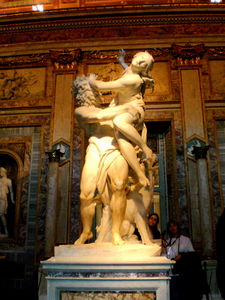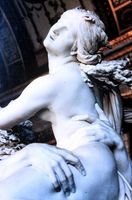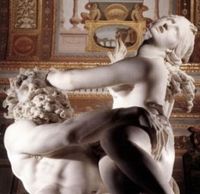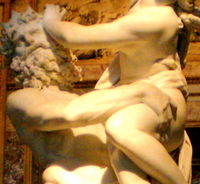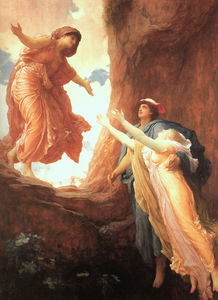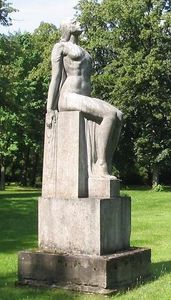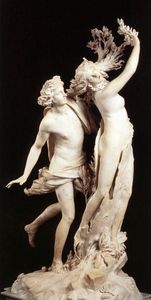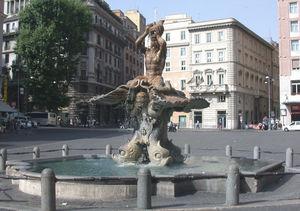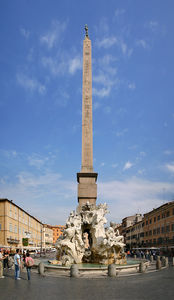The Rape of Persephone
- Alternative Names:
- The Rape of Proserpina
- Date of Creation:
- 1622
- Height (cm):
- 255.00
- Medium:
- Stone
- Subject:
- Figure
- Art Movement:
- Baroque
- Created By:
- Current Location:
- Rome, Italy
- Displayed at:
- Galleria Borghese
- Owner:
- Galleria Borghese
- The Rape of Persephone Page's Content
- Story / Theme
- Analysis
- Related Sculptures
- Artist
- Art Period
- Bibliography
The Rape of Persephone Story / Theme
In Greek mythology, Persephone (also known as Proserpina) was the daughter of Zeus and Demeter (goddess of agriculture) and was queen of the Underworld. One day while the young maiden was picking flowers, Hades, god of the underworld, kidnapped Persephone and carried her back to the underworld to be his wife.
Demeter begged Zeus to command the release of her daughter, and Persephone was told that she would be released from the underworld, as long as she didn't consume any food while she was there. But when she thought no one was looking, Persephone went into the garden and ate six pomegranate seeds. She was thus doomed to spend six months of the year with Hades, while for the other six months she could return to Earth to see her mother. The myth holds that the months Persephone spends in the underworld leave the earth cold, dark, and wintry, but when she returns, spring and summer accompany her.
Modern readers should note that in Bernini's time the word "rape" signified "kidnapping"; thus, the sculpture thus represents the kidnapping of Persephone.
The Commission:
Cardinal Scipione Borghese commissioned The Rape of Persephone from the 23-year-old Bernini in 1621, giving it to Cardinal Ludovisi in 1622. In 1908, the Italian state purchased the work and relocated it to the Galleria Borghese.
The Rape of Persephone Analysis
This stunning sculpture exemplifies the best of the baroque and demonstrates Bernini's ability to handle marble and produce credible figures. Like his other works, the Rape of Persephone is fraught with emotion and tension, achieving a hitherto unseen level of life-like action. Bernini's pieces can always be recognized by the minute attention to detail, grandiose theatricality, and ornate design.
Drama:
Bernini chooses to depict the most dramatic, "pregnant" moment in the story; the scene is filled with heart-rending emotion. Bernini is famous for portraying the most poignant moment in a story and for communicating that event in the most dramatic way possible, by means of exuberant movement, emotive facial expressions, and feats of technical mastery.
In The Rape of Persephone the figures twist and strain in opposing directions, testifying to a Mannerist influence; their tense struggle is imbued with an explosive dynamism.
Movement:
Not only are the figures portrayed in the midst of frenzied movement, but the viewer himself is encouraged to move 360 degrees around the sculpture in order to take it all in.
Naturalism:
These figures are hardly the gritty street walkers that populate Caravaggio's paintings, but certain details are breathtaking for the verisimilitude, especially the dimpling of Persephone's flesh as Pluto's fingers dig into her thigh and waist.
Although his figures are always somewhat idealized, like a perfected version of reality, Bernini manages to bestow them with individualized features and imbue them with human emotion, and never neglects the careful details that help to bring his sculptures to life.
The Rape of Persephone Related Sculptures
The Rape of Persephone Artist
With works such as The Rape of Persephone Bernini was not restricted by his materials; in carving his white marble he sought to create movement, life and warmth. His success is evident and as a true master of realism and emotion, he earned not only respect but a great following.
During his career Bernini had no shortage of commissions, much to the annoyance of other artists and imitators. He was one of the most admired and sought-after of artists, with the highest of reputations. Italian and French contemporaries praised the artist with detailed biographies, sure of the genius in their midst.
Naturally Bernini had his fair share of devoted followers. From contemporaries who worked directly under him or competed with him for commissions, up to modern artists who looked to his use of emotional multimedia design for inspiration, a multitude of artists can thank Bernini for the development of their own styles.
However in the backlash against the Baroque that occurred with the advent of Neoclassicism, the accolades faded into harsher criticisms.
Though the Baroque and Bernini along with it went out of fashion for a long period of time, in the 20th century he was "rediscovered" as a true master of realism and emotion, earning a renewed respect and influence on a new generation of artists, which continues up until this day.
The Rape of Persephone Art Period
Bernini's career spans the height of the Italian Baroque. Baroque art is profoundly tied to the religious and political context of 16th and 17th century Italy: after the Protestant Reformation, the Catholic Church launched its own Counter-Reformation to reaffirm its power and attract more followers to the faith.
In order to do so, the leaders of the church called for artistic spectacles that would captivate the attention, stimulate the senses, and elevate the soul: in consequence, Baroque art tends to the massive, dramatic, and theatrical.
Bernini's sculptures are recognizable for their theatrical, engaging drama, dynamism, tension, texture, and naturalism. The last two criteria (texture and naturalism) are perhaps the most particular to Bernini: no one can make stone convey soft skin, curling hair, or crinkling fabrics the way Bernini can.
His sculptures are also unique for the careful attention Bernini pays to the effects of light and shadow, effects which are traditionally more important to the painter than the sculptor. Many elements of Bernini's style reveal the influence of Mannerist and Hellenistic sculpture.
The Rape of Persephone Bibliography
Some of the most important academic resources on Bernini and his works include the following;
• Bauer, George, ed. Bernini in Perspective. Prentice-Hall, 1976
• Borsi, Franco. Bernini. Trans. Robert Erich Wolf. Rizzoli, 1984
• Gould, Cecil. Bernini in France: An Episode in Seventeenth-Century History. Weidenfeld and Nicolson, 1981
• Hibbard, Howard. Bernini. Penguin Books, 1965
• Lavin, Irving. Bernini and the Unity of the Visual Arts. For Pierpont Morgan Library by Oxford University Press, 1980
• Magnuson, Torgil. Rome in the Age of Bernini. Almqvist & Wiksell International
• Morissey, J. P. The Genius in the Design: Bernini, Borromini, and the Rivalry that Transformed Rome. Duckworth, 2005
• Wittkower, Rudolf. Gian Lorenzo Bernini: The Sculptor of the Roman Baroque. Cornell University Press, 1981

